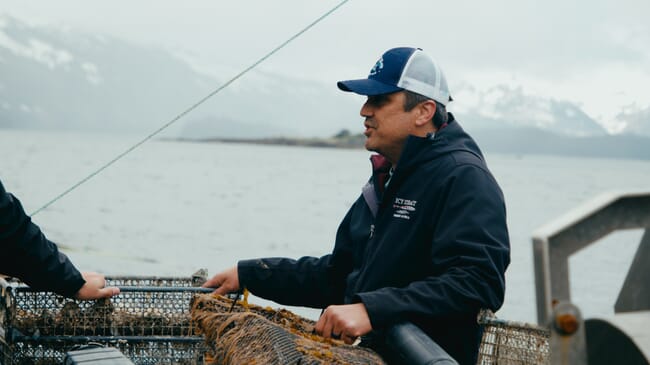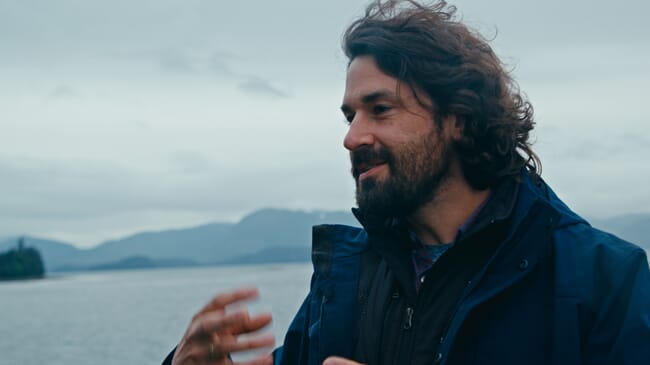
Though First Nations people were largely hunter-gatherers, aquaculture has been practiced in Southeast Alaska for at least 1,000 years. © The Fish Site / Hatch Innovation Services
“I’m proud to raise oysters right here in my own homeland,” says Anthony Lindoff, owner of Kaawu Shellfish in Alaska. A proud Tlingit, Anthony is known as ‘Eagle Wolf’ and has an international business degree. “Our Tlingit ancestors settled here because of its rich waters. There’s still so much life – eagles fishing, killer whales going by, otters swimming by and salmon jumping around – but there’s also a lot of shellfish you don’t see. We’ve got clams, mussels and of course, some of the tastiest oysters in the world,” he enthuses.
Lindoff is currently culturing over 120,000 Pacific oysters in Hoonah, a largely Tlingit community in Southeastern Alaska. “This sure is a tiny farm, but it’s my tiny farm,” he laughs.
Kaawu Shellfish uses traditional oyster rafts with submerged trays, plus oyster bags tied to floating longlines.
“The oysters, they grow like jiffy popcorn. It's just crazy how fast they grow. I’m always interested in ways to get my farm up to speed and I’m ready to take the next step,” he reflects.
To accelerate that next step for Lindoff and many other Alaskan mariculture operators, the Southeast Conference (SEC) is infusing the Alaskan mariculture scene with nearly $49 million through the Build Back Better Regional Challenge grant – dramatically enhancing capital access for the state’s oyster and kelp farmers. Like many places, Alaskan businesses suffered from the severe economic slowdown brought on by the Covid-19 pandemic.
“Alaska native communities are the original stewards of this region and have been doing mariculture from the get-go,” explains Robert Venables, executive director for SEC, the federally designated regional development organisation for Southeastern Alaska. With over 180 member organisations from 32 distinct communities, SEC is the lead entity charged with disbursing the grant over the next three years.
“We’re working with various Alaskan native community partners to help them create and develop new mariculture jobs. We want to create an economy that’s good for people, the environment, the planet, and is great for Alaska,” Venables explains.
The public funds will drastically lower the financial risks of local mariculture while incentivising private investments, particularly for oyster farms and kelp farms. The bulk of these investments is expected to come within the next five years.
“We chose our partners carefully to ensure that funds go where there will be greatest impact. We’re providing technical training to equip partners with the tools and skills needed to be successful in the long run. We don’t want to just invest in projects. We want to invest in people,” Venables stresses.

“We’re working with various Alaskan native community partners to help them create and develop new mariculture jobs. We want to create an economy that’s good for people, the environment, the planet, and is great for Alaska,” he notes. © The Fish Site / Hatch Innovation Services
Around half the funds are going to underserved communities, according to SEC deputy director Dan Lesh. “The Alaska Mariculture Cluster grant plans to allot 25 percent of the fund for Alaska native villages, businesses and individuals, plus another 25 percent for various rural communities. We want to be an example of a true partnership with communities, especially underserved ones.”
Alaska has a $6 billion-seafood industry, but almost all of it, notes Lesh, is currently wild-caught.
“Globally, there's already more seafood produced from aquaculture than from wild harvest fisheries – so in some ways, we're catching up with the rest of the world by learning to utilise our waters to produce more,” he observes.
Lesh thinks mariculture provides an opportunity to supply greener or less carbon-intensive products to the global economy, while boosting local food security and reducing the state’s reliance on imports. Kelp farms and forests for instance, are excellent carbon sinks which can help reduce the worst impacts of climate change.
“There's a lot of room for growth, room to make the mariculture space exactly what Alaskans want it to be,” he explains.
Back on his floating oyster farm in the Tlingit community of Hoonah, Lindoff dreams of a brighter tomorrow.
“I’m planning to put up my own oyster processing facility. I want to try direct retail as well. We’re gonna be having over half-a-million visitors this year from the cruise industry alone and that’s a lot of demand for top-quality Alaskan oysters,” he points out.
With the vital infusion of SEC funds, Lindoff and many of Alaska’s traditionally underserved mariculture players will finally get a chance not just to build back better after the pandemic – but also to build an industry that matches a way of life their people have practiced for generations.
*This article is part of a project commissioned by the SEC to highlight the region's mariculture sector. To learn more about the sector visit https://alaska.seaweedinsights...

“Globally, there's already more seafood produced from aquaculture than from wild harvest fisheries so in a way, we’re just catching up. There's a lot of room for growth, room to make the mariculture space exactly what Alaskans want it to be,” Lesh explains © The Fish Site / Hatch Innovation Services








